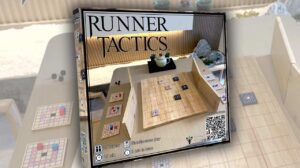Board gaming is an expensive hobby and expansions don’t help with that image. The idea of spending extra money on a game you already bought seems like a ridiculous proposal to the average consumer, and it’s a legitimate position to hold. There are some companies and genres where the entire business model is completely based on expansions. One simply has to look at deck builders such as Dominion and Ascension to see my point.
Expansions can be helpful outside of the usual financial benefits for the publishers. Designers can look at years of feedback from the players and figure out solutions to their original design that were an oversight in their playtests. From a player’s point of view, they get some fresh mechanisms to play around with and if the expansion was done well, elevate the game to a new level that could not simply be reached by the original game alone.
Then there are the duds.
Once these expansions are acquired and played, you get a feeling that your money could’ve been more productive by chucking it into the nearest fireplace or really, just buying some other new game. As someone who has been in this hobby for a stupidly long time, I have bought expansions that completely ruin the game experience or felt unnecessary. Some of the most well-respected and experienced publishers still produce these types of expansions. Today, we are going to study these examples of red flags together.

The 5th/6th player expansion
Game design is deliberate. There is a common misconception that game designers simply focus on mechanisms and this couldn’t be further from the truth. It’s like arguing that pizza is just pepperoni while ignoring the rest of the ingredients.
Every inch of cardboard is calculated in one form or another. Even the shape and amount of space the game occupies on a table are all designed to communicate an experience. It is something so subtle that many hobbyists fail to acknowledge it.
Besides the mechanisms and physicality, the players also play a part in the design. How much information is given to the player? How much table talk is allowed? Does it take a long time for a player to finish their turn? Are there windows of interaction for non-active players? What is the average timeframe to finish a round or the entire game? The answers to these questions are influenced by the designer’s intentions.
Armed with this newfound knowledge (or redundancy for some of you), you can see why adding more players via an expansion can be considered an investment disaster. If the original intention was four players max, it’s because it met parameters for mechanisms, strategies, downtime, and length of play. By throwing in an additional player or two into the mix, the timeframe of the game becomes negatively impacted, and certain gameplay elements can be completely skewed. The only time I can see expansions that add an additional player as acceptable is if it’s a game with simultaneous play.

Early expansions
Playtesting is a core component of game design, especially in this Kickstarter age where everyone and their Instagram-friendly dog can get a board game funded. Due to this environment where board gamers have countless options to pick from, playtesting is an essential tool to make a game’s foundations stand out from the crowd. Board gamers don’t have time for poorly tested games and word of mouth travels fast on the internet.
The core issue with expansions is that they are not tested as thoroughly as the base game. It is why you often hear complaints about expansions saying they “ruin the balance” or skews the game into a direction that devalues the substance of the game. This isn’t to say that every expansion is bad, but you do have to take caution if you decide to take the plunge.
One of the easiest ways to measure the risk of expansion is the time gap between the base game’s release and expansion. If the expansion was released as a “Kickstarter exclusive” stretch goal or as a separate pledge, that doesn’t give much confidence that it went through the same playtesting standards as the base game.
Time shouldn’t be the only measurement. There are game publishers out there with a business model designed around continuous expansions and game designers that seem to be hardwired to produce reasonable expansions at a moderate pace. These are exceptions and shouldn’t be considered the “norm” for board game expansions.

Modules
There are two types of expansions for board games: Full-sets and modules. Full-sets are designed to be fully integrated into the base game while modules are small expansions that are optional, and thus can be mixed and matched.
The concept sounds like a good deal. You get to tailor your experience with the modules by interjecting as little or as much as you want. It also will appeal to a wide range of players since you can vary the complexity of your game with these modules.
Unfortunately, a few problems begin to bubble on the surface after several plays. One of the immediate issues is the lack of playtesting. Since these modules can be mixed with as little or as much as with the other modules, it means there are numerous combinations of scenarios to test out. Oftentimes, far too many. Publishers and designers don’t have the time to test every single variable, leading to a very inconsistent experience.
Due to the freeform nature of modules, you will likely encounter modules that don’t work well with your group or worst yet, the game itself. The cost of modules isn’t just components, but playtesting as well, and you are potentially paying for something that you will never use. From a value proposition standpoint, module expansions are generally not a good deal.

Bloated Complexity
Expansions are designed to…expand. Acute observation, I know. The original idea is to introduce more interesting decisions to the core mechanisms of the game without mugging up the experience under a complexity fog. A build wide, not tall, type of scenario.
Think of expansions as a spice to a finely cooked meal. If done well, it will elevate the dish but throw it in without restraint, and it just destroys the meal. A good expansion preserves the integrity of the game while a poor one smothers it.
This isn’t to say complexity is a bad thing. There are a few expansions, such as Viticulture’s Tuscany expansion, that did a great job transforming a decent game into an excellent one, but these expansions aren’t the standard affair. The issue lies that most complex expansions often turn the core game into something that could feel very unrecognizable. Sometimes it becomes an annoying distraction. The more complex the expansion, the higher chance that the expansion is a dud.
Take for example, Roll for the Galaxy’s Rivalry expansion. Not only does this add several different modules to the game, but it also costs more than the base game itself. The complexity of these modules turns this fast-paced rolling tableau builder into an aberration of customizing the face of your dice and deciphering player negotiation with far more symbols than a Rosetta Stone. It’s like watching Sesame Street turning into a homicide detective show without the parody subtext.

Replacing your components
There are some expansions out there designed to “fix” the game. They are often a subject of controversy due to their very nature. If the game went through so much playtesting, why is there a need to change the original components?
There is a reasonable argument for this. When a game becomes unleashed to the retail wildlife, you can have hundreds if not thousands of more players playing your game. It means more game sessions and more feedback. It could be possible that someone managed to break the game due to something that hundreds of players completely missed out. It has happened to even the most well-produced games such as Scythe with post-release balance changes. Sometimes these expansions can elevate mediocre games into something more enjoyable by their fans.
So what is the red flag? It is less to do with the expansion itself and more about the perception of the game. If a game requires significant changes to make it appear more balanced, it does bring in legitimate concern about quality control. When an expansion requires you to replace the components that you previously bought, it does leave a sour taste even if it’s for good intentions.
Think about this for a moment. You’ve spent 30 bucks on an interesting card game and a new expansion is announced. This expansion is an extra $20 and it replaces a deck of cards while throwing in some new content. The game does appear fixed with this expansion, but now you nearly paid double for your game.
This sounds like a made-up scenario but it happened. That game is called Eminent Domain, a 2011 deck-builder role selection space genre that is underappreciated. The original base game was lacking in content and had some issues with the Military playstyle. The “Escalation” expansion fixed this by adding more starting worlds, asymmetrical powers, and completely replacing your technology deck to accommodate the new Military rules. It turned a $30 game into a $50 game. For some players, that is completely unacceptable and it is understandable why people might find themselves sympathetic to this reasoning.
So nay to Expansions, then?
It would be hypocritical for me to say that you shouldn’t buy expansions, since I tend to buy them myself and I don’t want to give the impression that every expansion is bad. Just like any other product or service, research is needed to make sure what you are getting isn’t a bust. There are plenty of good expansions out there that are worth your time and money. Consider this small list a bit of wisdom and experience from yours truly about what to look out for when you decide to shop around for an expansion to your favorite game or two.











I think you are making stuff to make stuff up! Or that you need more friends, some people only go for games that have 5 or more, making this a prerequisite for the game. And with extra players and down time comes added time for socializing which is the main reason to play isn’t it?
“And with extra players and down time comes added time for socializing which is the main reason to play isn’t it?”
No.
There’s also the expansions that introduce different modes – like a solo or co-op version. (The DC Comics DBG Crisis expansions, for example.) As you say with the 5-6 player expansions – if the game wasn’t designed with it in mind, grafting it on usually isn’t going to work.
Totally agree. Many expansions subvert the whole feel of the game. My favorite example (which everyone else seems to love) is Terrafoming Mars Prelude, which is aimed at impatient people. First of all, TM is an engine builder, so if you don’t like that why are you playing it? But the real problem is that by shortening the game by 2 or more rounds, it devalues every token accumulating card, and makes some late game cards not worth putting out. Terrible expansion.
A common misunderstanding. Prelude does not eliminate the last two generations. It eliminates the first two. And since most resource accumulating cards do not come out early (they are locked by requirements), there is no change to the value of these cards.
I like that the illustration for the article appears to be for Magic the Gathering. CCGs seem to have dominated the questionable expansions, though with little to show in terms of enjoyment, in my opinion. Their new cards and rules seem designed to favor (as a business model) new cards at the expense of old card sets.
I thought it was a scam when I was managing a game store.
But while I am a completionist, I’ve more recently been more considerate of trying to complete my collection of board games. This guy has interesting thoughts about why to try to complete a set, and why to abandon a set.
One set I abandoned completing was Carcassone. My problem: first, the newer North American distributor/ producer made a decision that the old production tiles would not match the new production, second, there are hundreds of small run expansions requiring a major financial investment to purchase them. A third issue is that there was poor consideration of some of the expansions. In particular, there was an expansion called the Catapult which emphasized physical dexterity. The physical manipulation of objects was never an important goal of the game. Thus it became obvious that new annual expansions were primarily for the financial benefit of HiG, the German owner.